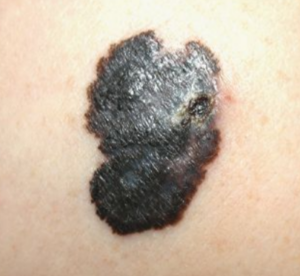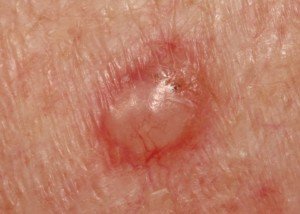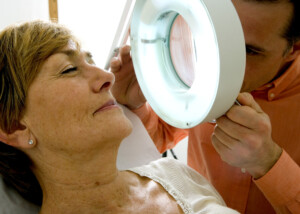Basal cell carcinoma is typically described as a nodule or bump that may be pearly in color, but also flesh toned or some range of pink.
Purple is a color that may come to mind for some people concerned over discovering a stubborn nodule or small bump on their skin that just won’t go away.
Though basal cell carcinoma is the least evil of all the different kinds of cancer that can affect the skin… hearing, “You have basal cell cancer,” can still leave a person sleepless the following night.
If neglected (ignored, not treated), this malignancy can cause serious local destruction of nearby tissue.
The Color Purple
“Basal cell carcinoma can present as a flesh-colored or brown spot on the skin,” says Dr. Gretchen Frieling, MD, Triple Board Certified Boston Area Dermatopathologist.
“It can also present itself as a bleeding or scabbing lesion that heals and returns,” continues Dr. Frieling.
“In those instances, the scabbing can make it look a bit purple, but basal cell carcinoma is usually identified by its pearly, light color or a brown spot.

A basal cell carcinoma lesion displaying a scabby, brownish-dull purple appearance.
“Kaposi sarcoma, however, is a more rare form of cancer that occurs in the skin’s blood vessels and can cause purple or red patches of skin.”
If you’re diagnosed with a basal cell carcinoma, do not panic. This type of tumor very rarely metastasizes, even when local destruction has already occurred.
It also cannot turn into melanoma, the most serious form of skin cancer.
But if you suspect that the stubborn pimple-like lesion on your forehead, nose, cheek, near the eye, ear, scalp or any sun-exposed body might be a BCC, do not put off getting it examined just because you just read that a BCC very rarely spreads to other parts of the body.
Promptly get it examined — because melanoma can mimic the appearance of a basal cell carcinoma to the untrained eye.
Any spot, nodule, bump, blemish or patch on the skin that doesn’t go away after two or three weeks should be examined by a dermatologist, regardless of color – be it flesh, pink, purple, brown, tan or whatever.


 Dr. Frieling’s website is
Dr. Frieling’s website is
























